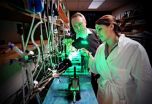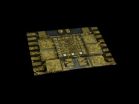(Press-News.org) Igor Efimov, PhD, at the School of Engineering & Applied Science at Washington University in St. Louis and an international team of biomedical engineers and materials scientists have created a 3-D elastic membrane made of a soft, flexible, silicon material that is precisely shaped to match the heart's epicardium, or the outer layer of the wall of the heart. Current technology is two-dimensional and cannot cover the full surface of the epicardium or maintain reliable contact for continual use without sutures or adhesives.
The team can then print tiny sensors onto the membrane that can precisely measure temperature, mechanical strain and pH, among other markers, or deliver a pulse of electricity in cases of arrhythmia. Those sensors could assist physicians with determining the health of the heart, deliver treatment or predict an impending heart attack before a patient exhibits any physical signs.
The findings were published online in Nature Communications Feb. 25, 2014.
"Each heart is a different shape, and current devices are one-size-fits-all and don't at all conform to the geometry of a patient's heart," says Efimov, the Lucy & Stanley Lopata Distinguished Professor of Biomedical Engineering. "With this application, we image the patient's heart through MRI or CT scan, then computationally extract the image to build a 3-D model that we can print on a 3-D printer. We then mold the shape of the membrane that will constitute the base of the device deployed on the surface of the heart."
Ultimately, the membrane could be used to treat diseases of the ventricles in the lower chambers of the heart or could be inserted inside the heart to treat a variety of disorders, including atrial fibrillation, which affects 3 million to 5 million patients in the United States.
"Currently, medical devices to treat heart rhythm diseases are essentially based on two electrodes inserted through the veins and deployed inside the chambers," Efimov says. "Contact with the tissue is only at one or two points, and it is at a very low resolution. What we want to create is an approach that will allow you to have numerous points of contact and to correct the problem with high-definition diagnostics and high-definition therapy."
Co-leading the team with Efimov is John Rogers, PhD, the Swanlund Chair and professor of materials science and engineering and director of the F. Seitz Materials Research Laboratory at the University of Illinois at Urbana-Champaign. Rogers, who developed the transfer printing technique, developed the sensors using semiconductor materials including silicon, gallium arsenide and gallium nitride, along with metals, metal oxides and polymers.
Recently, Google announced its scientists had developed a type of contact lens embedded with sensors that could monitor glucose levels in patients with diabetes. Efimov says the membrane his team has developed is a similar idea, though much more sophisticated.
"Because this is implantable, it will allow physicians to monitor vital functions in different organs and intervene when necessary to provide therapy," he says. "In the case of heart rhythm disorders, it could be used to stimulate cardiac muscle or the brain, or in renal disorders, it would monitor ionic concentrations of calcium, potassium and sodium."
Efimov says the membrane could even hold a sensor to measure troponin, a protein expressed in heart cells and a hallmark of a heart attack. Analysis for troponin is standard of care for patients with suspected heart attacks due to a test developed by Jack Ladenson, PhD, the Oree M. Carroll and Lillian B. Ladenson Professor of Clinical Chemistry in Pathology and Immunology and professor of clinical chemistry in medicine at the School of Medicine.
Ultimately, such devices will be combined with ventricular assist devices, Efimov says.
"This is just the beginning," he says. "Previous devices have shown huge promise and have saved millions of lives. Now we can take the next step and tackle some arrhythmia issues that we don't know how to treat."
INFORMATION:
The School of Engineering & Applied Science at Washington University in St. Louis focuses intellectual efforts through a new convergence paradigm and builds on strengths, particularly as applied to medicine and health, energy and environment, entrepreneurship and security. With 82 tenured/tenure-track and 40 additional full-time faculty, 1,300 undergraduate students, 700 graduate students and more than 23,000 alumni, we are working to leverage our partnerships with academic and industry partners — across disciplines and across the world — to contribute to solving the greatest global challenges of the 21st century.
Xu L, Gutbrod S, Bonifas A, Su Y, Sulkin M, Lu N, Chung H-J, Jang K-I, Ying M, Lu C, Webb C, Kim J-S, Laughner J, Cheng H, Liu Y, Ameen A, Jeong J-W, Kim G-T, Huang Y, Efimov I, Rogers J. 3D multifunctional integumentary membranes for Spatiotemporal cardiac measurements and stimulation across the entire epicardium. Nature Communications. 5:3329 doi: 10.1038/ncomms4329 (2014). Published online Feb. 25, 2014.
Funding for this research was provided by the National Institutes of Health R01 HL115415, R01 HL114395 and R21 HL112278; the Frederick Seitz Materials Research Laboratory and Center for Microanalysis of Materials at the University of Illinois at Urbana-Champaign.
3-D printer creates transformative device for heart treatment
2014-02-25
ELSE PRESS RELEASES FROM THIS DATE:
Vitamin A may help boost immune system to fight tuberculosis
2014-02-25
Tuberculosis is a major global problem, affecting 2 billion people worldwide and causing an estimated 2 million deaths annually. Western countries are once again tackling the disease, with recent outbreaks in Los Angeles and London.
The rise of drug-resistant TB, called a "ticking time bomb" by the World Health Organization, and the high cost of fighting the disease highlight the need for new approaches to treatment.
In findings published in the March 1 issue of the Journal of Immunology, UCLA researchers investigating the role of nutrients in helping the immune ...
Discovery of a 'conductor' in muscle development
2014-02-25
Montréal, February 25, 2014 – A team led by Jean-François Côté, researcher at the IRCM, identified a ''conductor'' in the development of muscle tissue. The discovery, published online yesterday by the scientific journal Proceedings of the National Academy of Sciences (PNAS), could have an important impact on the treatment of muscular diseases such as myopathies and muscular dystrophies.
"For several years, we have been studying myogenesis, a process by which muscles are formed during embryonic development," says Jean-François Côté, PhD, Director of the Cytoskeletal Organization ...
Psychological side-effects of anti-depressants worse than thought
2014-02-25
LIVERPOOL, UK – 26 February 2014: A University of Liverpool researcher has shown that thoughts of suicide, sexual difficulties and emotional numbness as a result of anti-depressants may be more widespread than previously thought.
In a survey of 1,829 people who had been prescribed anti-depressants, the researchers found large numbers of people – over half in some cases – reporting on psychological problems due to their medication, which has led to growing concerns about the scale of the problem of over-prescription of these drugs.
Psychologist and lead researcher, Professor ...
New record set for data-transfer speeds
2014-02-25
WASHINGTON, Feb. 25, 2014 – Researchers at IBM have set a new record for data transmission over a multimode optical fiber, a type of cable that is typically used to connect nearby computers within a single building or on a campus. The achievement demonstrated that the standard, existing technology for sending data over short distances should be able to meet the growing needs of servers, data centers and supercomputers through the end of this decade, the researchers said.
Sending data at a rate of 64 gigabits per second (Gb/s) over a cable 57 meters long using a type ...
NHS Scotland reduces post-code lottery for hip replacement surgery
2014-02-25
Tuesday 25 February – A reduction in the post-code lottery for hip replacement surgery has been achieved in Scotland without recourse to the private sector, according to new research published in the Journal of the Royal Society of Medicine. Using NHS Scotland data, researchers at the Centre for Primary Care and Public Health at Queen Mary University of London with colleagues from the University of Edinburgh and Lothian University Hospitals NHS Trust, show that access to hip replacement increased and geographical inequalities improved across all geographical health boards ...
Researchers generate new neurons in brains, spinal cords of living adult mammals
2014-02-25
DALLAS, Feb. 25, 2014 – UT Southwestern Medical Center researchers created new nerve cells in the brains and spinal cords of living mammals without the need for stem cell transplants to replenish lost cells.
Although the research indicates it may someday be possible to regenerate neurons from the body's own cells to repair traumatic brain injury or spinal cord damage or to treat conditions such as Alzheimer's disease, the researchers stressed that it is too soon to know whether the neurons created in these initial studies resulted in any functional improvements, a goal ...
Does solitary confinement fuel more crime?
2014-02-25
EAST LANSING, Mich. — Solitary confinement does not make supermax prison inmates more likely to re-offend once they're released, finds a study on the controversial penitentiaries led by a Michigan State University criminologist.
The study – one of the first to examine recidivism rates among supermax inmates – refute critics' claims that serving extended time in isolation leads to more crime. Super-maximum security units, known as supermax units or prisons within prisons, are designed to house problematic inmates by keeping them isolated for as long as 23 hours a day.
Jesenia ...
Small start-up businesses in rural areas must hustle for loans from far-off banks
2014-02-25
To better their survival chances, entrepreneurs and owners of small businesses in rural areas must successfully pitch their ventures to "faraway, unknown banking officials" rather than relying on local lenders as in the past, according to Baylor University researchers.
Increasingly, bank branches are headquartered in distant urban areas – and in some cases, financial "deserts" exist in towns with few or no traditional financial institutions such as banks and credit unions. That means that local lending to individuals based on "relational" banking — with lenders being aware ...
New risk gene illuminates Alzheimer's disease
2014-02-25
A team of international scientists, including a researcher from Simon Fraser University, has isolated a gene thought to play a causal role in the development of Alzheimer's disease. The Proceedings of the National Academy of Sciences recently published the team's study.
The newly identified gene affects accumulation of amyloid-beta, a protein believed to be one of the main causes of the damage that underpins this brain disease in humans.
The gene encodes a protein that is important for intracellular transportation. Each brain cell relies on an internal highway system ...
Prevalence of high school seniors' marijuana use is expected to increase with legalization
2014-02-25
National support for marijuana ("cannabis") legalization is increasing in the United States (US). Recreational use was recently legalized in the states of Colorado and Washington; other states across the country are expected to follow suit. To date, an additional 15 states have decriminalized marijuana use, and 19 states and the District of Columbia now allow medical marijuana to be prescribed.
Now, a study published in the International Journal of Drug Policy by researchers affiliated with New York University's Center for Drug Use and HIV Research (CDUHR), finds large ...



